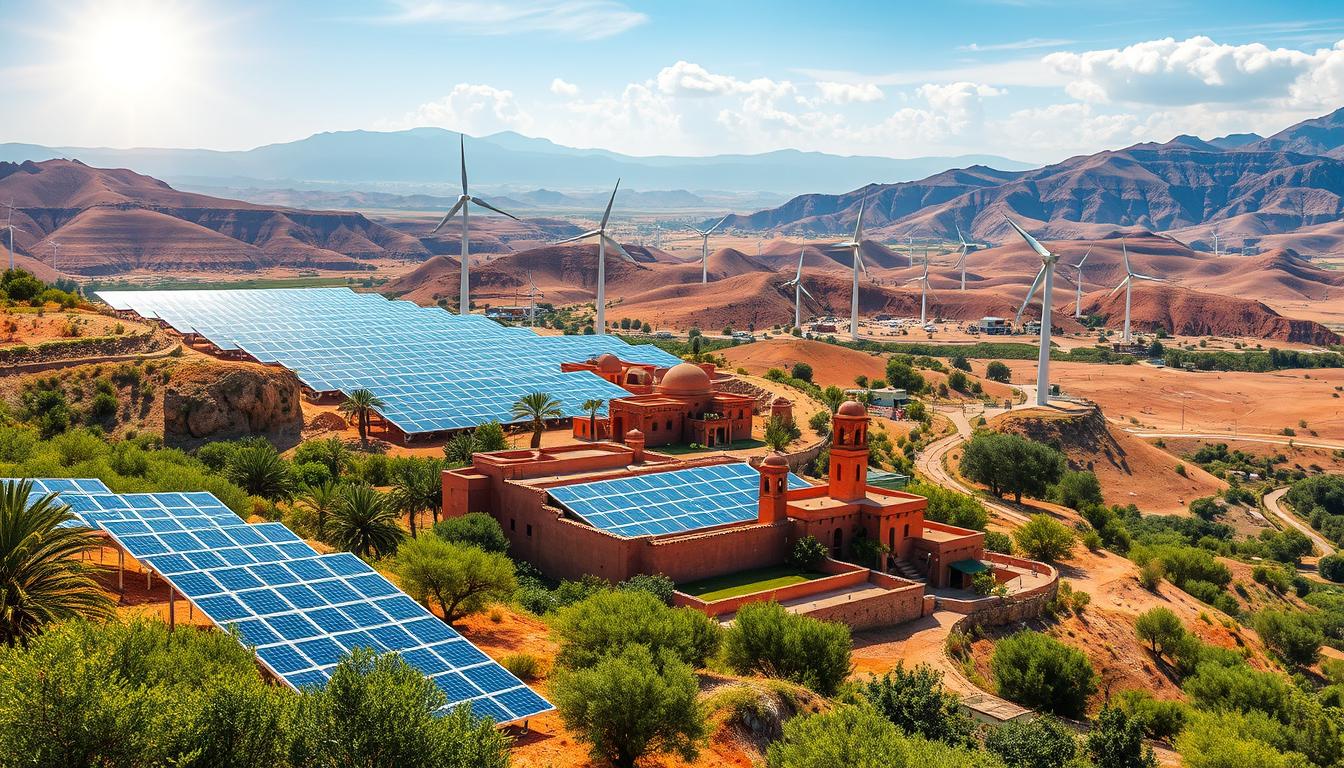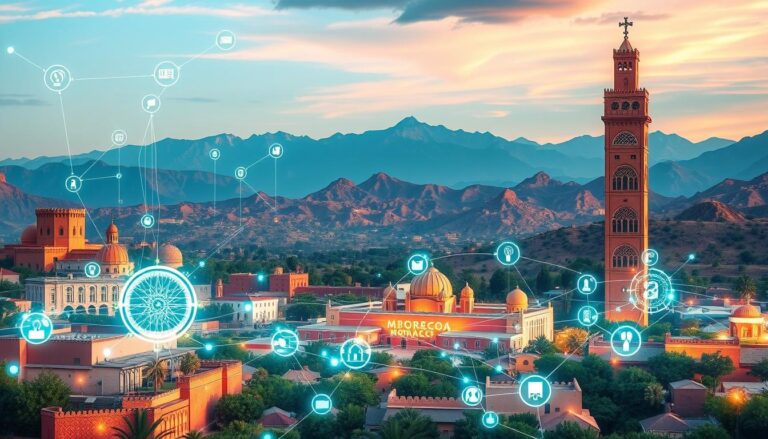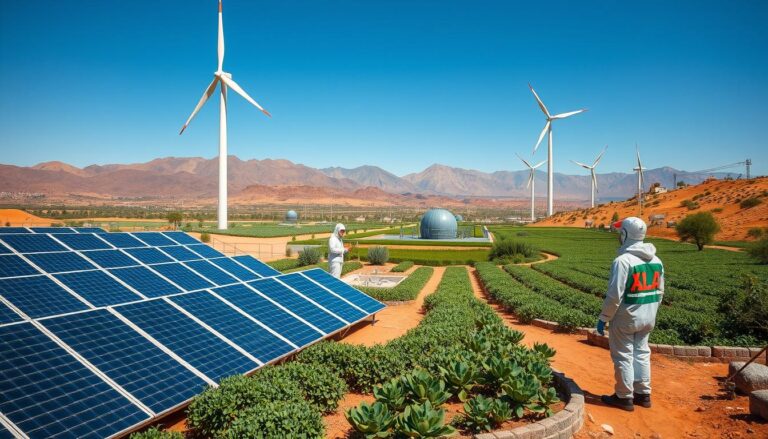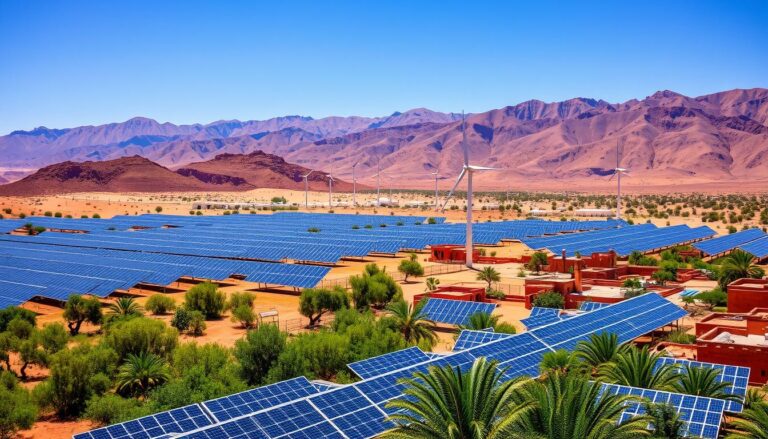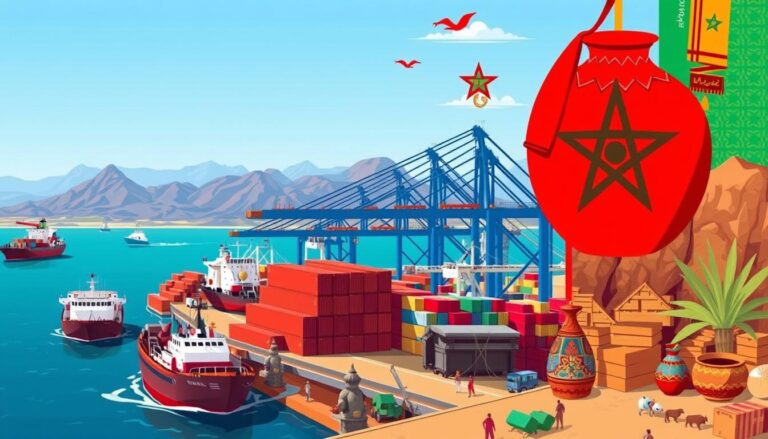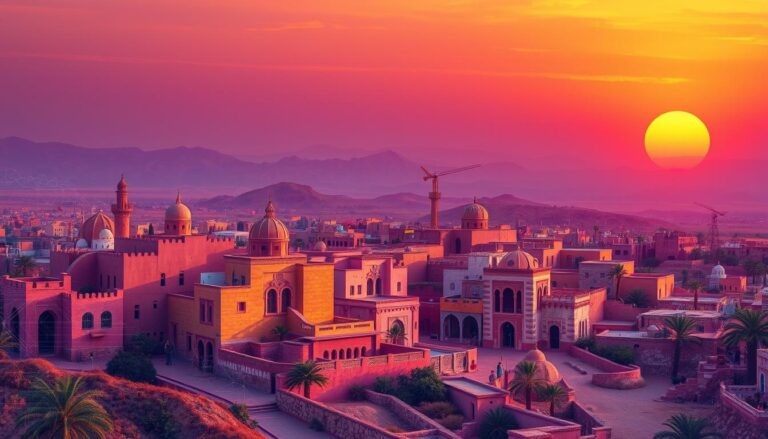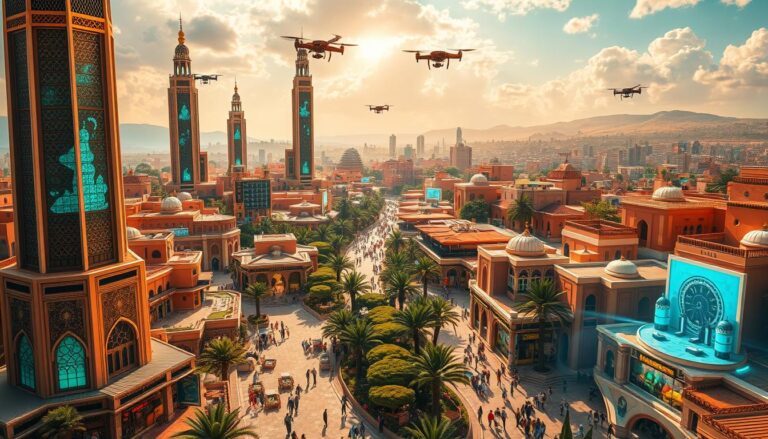Have you ever thought about how a country can grow in sustainable development and lead in digital transformation at the same time? Morocco is changing its role in the world. It’s doing this by mixing renewable energy with new innovation. This move aims to make the country greener and more tech-savvy.
The country’s plan is not just about using green technology. It’s a big step towards becoming a model for smart and sustainable cities worldwide.
Morocco’s National Energy Strategy was set in 2009. It aims to cut greenhouse gas emissions by 2030, as promised in the Paris Agreement. Hosting COP22 in Marrakech was a key moment. It showed Morocco’s strong commitment to fighting climate change and its role as a bridge between Europe and Africa.
Energy and technology come together here. Big investments in clean energy research, development, and innovation (R&D&I) are leading the way. This future will see energy efficiency solutions and smart grids everywhere.
So, what drives Morocco’s big dreams? It’s a smart plan that uses local strengths and follows global trends. The creation of the Institute for Research in Solar Energy and New Energies (IRESEN) shows this strategy in action. It combines research, government support, and policy for a sustainable energy future.
But how will these efforts affect the world? And what will be their impact on global energy security?
Introduction: Understanding Morocco’s Energy and Technology Synergy
Morocco is leading the way in combining energy and technology. It aims to be more energy independent and use clean energy. This makes Morocco a key player in Africa’s tech scene.
The country’s energy plan focuses on using clean energy and new technologies. Morocco’s location near Europe and in Africa helps it work with other countries. This is part of its goal to meet its energy needs.
“The rise of renewable energy projects, coupled with investments in R&D and technological infrastructure, contributes significantly to Morocco’s aspirations,” said a leading energy analyst.
In 2021, Morocco’s power generation hit 8154 MW. Renewable energy made up 10% of this. Solar, wind, and hydropower were the main sources.
Using clean energy is key for Morocco. It produces 28,000 GWh of power and imports more from Spain. This move shows Morocco’s commitment to the environment and a sustainable future.
The Evolution of Morocco’s National Energy Strategy
Morocco launched its National Energy Strategy in 2009. It aimed to improve energy security and reduce imports. The plan also set ambitious goals for renewable energy.
Since then, Morocco has made big steps in renewable energy and reducing pollution.
Key Policies and Milestones
Morocco’s climate change policy is built on its National Energy Strategy. Key policies include:
- Renewables now make up 42% of electricity by 2022, meeting a 2020 goal.
- By 2030, renewables will make up 52% of electricity, with solar, wind, and hydropower leading the way.
- Almost all homes now have electricity, improving life and business.
- Goals to cut greenhouse gases and fight global warming are in place.
Impact on Energy Security and Environmental Preservation
Morocco’s energy reforms have greatly improved energy security and the environment. By focusing on renewables, it has cut down on energy imports. For instance, in 2014, it spent about $10 billion on energy imports.
Now, with more renewable energy, this cost is going down. Morocco is also fighting climate change by meeting and beating its renewable targets.
As electricity demand grows, Morocco’s policies ensure it’s met in a green way. Morocco’s renewable energy push is a model for the MENA region. It shows a path to a sustainable and secure energy future.
Renewable Energy Pathways in Morocco
Morocco is leading the way in renewable energy, using its natural resources wisely. It aims to get 52% of its power from clean sources by 2030. This will include solar, wind, and hydropower.
Solar Energy Initiatives
The Noor Solar Plan is a key project for Morocco. The Noor Ouarzazate complex is the world’s largest solar plant. It’s a big step towards clean energy and reducing carbon emissions.
Morocco is serious about green energy. Solar panel prices have fallen, making it easier for families to use solar power. This is a big part of Morocco’s energy plan.
Wind Energy Development
Morocco is also growing its wind energy. Big wind farms in Tarfaya use the Atlantic winds for power. The goal is to balance solar and wind energy.
This growth helps the environment and creates jobs. It also brings new tech to the area.
Hydropower Projects
Morocco is also focusing on hydropower. It uses dams and small hydro plants to manage water and energy. This is crucial for areas facing water shortages.
Morocco’s mix of solar, wind, and hydropower shows its commitment to a green future. It’s a step towards a more sustainable energy system.
The Role of Innovation in Morocco’s Energy Sector
Innovation is key to Morocco’s energy sector growth. It brings sustainable development through new technologies. The focus is on Clean Energy R&D, backed by strong research and institutions like IRESEN.
Research and Development Efforts
Morocco is boosting Clean Energy R&D. It plans to double its investment to 80 million € by 2023. This shows Morocco’s dedication to innovation, encouraging teamwork with global partners.
Key Players and Institutions
Many players lead Morocco’s Green Technology push. IRESEN funds research in renewable energy, working with businesses and universities. Morocco also works with the International Energy Agency (IEA) on energy security and efficiency.
Technological Advancements and Breakthroughs
Morocco is making big strides in energy tech. The Noor Ouarzazate project shows CSP’s power. The Sahara Wind Power Project also shows wind’s potential for electricity.
These projects show Morocco’s role in green tech. They mark big steps towards meeting renewable energy goals.
Smart Grids and Their Implementation in Morocco
Morocco is moving towards a green energy future. Smart Grid Integration is key to this effort. These advanced grids make energy distribution more efficient and reliable, helping the country switch to cleaner energy.
Importance of Smart Grids
Smart grids are crucial for a stable and flexible electric power system. They use real-time data and automated systems. This boosts energy efficiency and modernizes the grid.
According to the International Journal of Energy Economics and Policy, smart grids are vital. They help optimize system performance through energy modeling.
Integration with Renewable Energy
Smart grids and renewable energy work together in Morocco’s energy plan. They manage the ups and downs of solar and wind power. This partnership aims to make energy supply reliable.
Morocco wants 52% of its energy to come from renewables by 2030. Micro-grids and island systems help achieve this goal. They ensure a balanced and sustainable energy mix.
Challenges and Opportunities
Smart Grid Integration brings many benefits but also challenges. It needs new technology, lots of money, and the right rules. But the rewards are worth it.
Smart grids improve energy monitoring and efficiency. They make energy systems more reliable. They also create a new way for energy suppliers and consumers to work together.
Development of Green Technology and Its Impact
Morocco has made big strides in Green Technology Development. It has set up Green Innovation Hubs. These hubs are key for Sustainable Tech Innovation and Morocco’s Eco-friendly Solutions.
Green Innovation Hubs
The Green Energy Park in Benguerir is a top Green Innovation Hub. It focuses on solar and renewable energy research and development. The park aims to lower the cost of solar cells, following global trends.
It also looks into solar thermal energy systems. This makes Morocco a leader in Solar Energy Innovations.
Success Stories and Case Studies
The Noor Ouarzazate project is a big Renewable Energy Success Story. It uses the sun’s power to cut energy costs and provide reliable energy. It’s set to start producing electricity in summer 2018.
Foreign and domestic private contractors are working on it. They aim to cut carbon emissions and boost the local economy.
Noor Ouarzazate’s success shows the drop in solar technology costs. This success is also seen in sustainable mobility solutions. It shows Morocco’s dedication to green technology.
Morocco’s journey shows how Sustainable Tech Innovation meets eco-friendly solutions. It highlights the big impact of Green Technology Development on Morocco’s renewable energy.
Morocco as a Regional Energy Hub
Morocco has quickly become a leader in clean energy. It has made big investments and set strong policies. This move is key for Morocco’s energy future and its role in Regional Energy Leadership and the Africa-Europe Energy Bridge.
Morocco is focusing on renewable energy projects like the Noor Ouarzazate solar complex. This shows its commitment to clean energy.
Leadership in Clean Energy Technologies
Years ago, PV solar cells were too expensive for many Moroccans. But, thanks to global tech investments, costs have dropped. Now, PV solar is cheaper than coal.
Projects like Noor Ouarzazate show Morocco’s lead in Concentrated Solar Power (CSP). This technology provides reliable energy, even when it’s not sunny. It shows how Morocco can use less traditional energy.
The Noor Ouarzazate project is a big deal for Morocco and the region. It started producing electricity in the summer of 2018. This is a big step towards making renewables as good as fossil fuels.
Projects like this are key in the fight against climate change. They help make a big change towards renewable energy.
Collaboration with Neighboring Countries
Morocco is not just working on its own energy projects. It’s also working with other countries. Morocco imports electricity from Spain and helps the Middle East and North Africa use more renewables.
By doing this, Morocco helps communities get electricity and boosts the economy. This makes Morocco more influential in the region and helps with energy independence.
Morocco also wants to fight poverty by making energy cheaper and more available. From 1990 to 2010, more people got electricity. Morocco is leading the way to a sustainable energy future for all.
Energy Efficiency Solutions in Morocco
Morocco is serious about energy conservation. It has created energy efficiency solutions to cut down energy use in many areas. The country uses energy management systems to make homes and businesses more efficient. This is important because Morocco gets over 75% of its energy from outside its borders.
Eco-innovation is key in Morocco’s sustainable energy practices. The PNEEI program is a big example. It wants to switch irrigation to drip systems on 920,000 hectares by 2030. This will save a lot of water and energy.
The commercial sector, like agriculture, uses 22.4% of Morocco’s electricity. Agriculture uses about 7% of energy, mostly from diesel and gas. Solar-powered drip irrigation is a big part of Morocco’s water use, showing its commitment to sustainable energy practices.
Morocco is also working on its energy future. It wants to use 42% of its electricity from renewable sources. The Noor Solar Complex in Ouarzazate is a big step towards eco-innovation and less expensive energy imports.
Challenges in Morocco’s Energy and Technology Landscape
Morocco’s energy and tech sector faces many challenges. The country must deal with the climate impact on energy, manage resources well, and consider socio-economic factors. These issues are linked to the water-energy-food nexus, making sustainable development harder.
Climate Change and Its Implications
Climate change affects Morocco’s energy plans a lot. The country has seen a drop in rainfall, making water scarce. This affects farming and energy production, showing the need for better resource management.
Morocco’s use of fossil fuels has increased its carbon footprint. It now stands at around 1.74 metric tons per capita.
Water-Energy-Food Nexus
The water-energy-food nexus is complex for Morocco. Using seawater desalination to get water adds to energy needs, mainly from fossil fuels. Switching to renewable energy is key for sustainable farming and energy use.
This approach helps in managing resources better. It ensures all sectors are sustainable, boosting socio-economic resilience.
Socio-Economic Factors
Morocco’s energy scene is also shaped by socio-economic factors. The country spent over MD24bn ($2.9bn) on rural electrification from 1996 to 2012. This effort greatly increased electricity access, from 22% to almost 98%.
Yet, Morocco still needs to improve its socio-economic resilience. High energy import costs, over US$11bn in 2014, highlight the need for self-sufficiency and resilience against global price changes.
Sustainable Development Goals and Morocco’s Commitment
Morocco leads in meeting the Sustainable Development Goals (SDGs) set by the United Nations in 2015. The Moroccan government is fully committed to these goals. It shows a strong dedication to environmental protection and sustainable development.
National and International Initiatives
Morocco shows its commitment through many national and international efforts. It aims to cut greenhouse gas emissions by 42% by 2030. The country focuses on renewable energy like wind, solar, and hydroelectric power.
Morocco also plays a big role internationally. It works with The Paris Agreement and The 2030 Agenda for Sustainable Development.
Some key achievements include:
- Planning to get 42% of its electricity from renewable sources by 2020.
- Expanding renewable energy capacity by $13 billion.
- Using water recycling and desalination for sustainable industries.
Future Ambitions and Roadmaps
Morocco has big plans for the future. By 2030, it aims to add 4262 MW of energy, mostly from renewables. It also plans to make 52% of its energy renewable and cut greenhouse gas emissions.
Key parts of Morocco’s energy strategy include:
- Building demand for green hydrogen, aiming for 10.3 TWh to 21.7 TWh by 2030, and more by 2050.
- Using new technologies and partnerships for better energy.
- Supporting global nuclear energy growth, showing Morocco’s commitment to energy solutions.
Morocco’s focus on SDGs makes it a key player globally. It sets a high standard for sustainable development and environmental care.
The Future of Morocco’s Energy and Technology Nexus
Morocco is on a path to lead in energy and tech. It’s focusing on Prospects of Renewable Energy and building a Sustainable Tech Ecosystem. The goal is to grow its renewable energy and find new ways to keep the future safe and strong.
“The shift to renewable resources, specifically Solar PV, in arid regions is crucial for sustainable development and efficient farm production.”
Under Morocco’s Energy Vision, big projects are starting. They aim to triple desalination by 2030 to solve water shortages. A $40 billion plan for water will be key for modern farming.
Microgrid systems are being used to help farming. They make energy use better and water management easier. This shows Morocco’s commitment to Innovative Energy Solutions and a green future.
By 2019, Morocco got 35% of its power from renewables. It wants to hit 52% by 2030. The plan is to use less coal and more natural gas. This will help the environment and make Morocco a leader in North Africa.
Digitalizing energy opens new doors. Morocco is working on better energy management. This includes using electricity to improve farming and water use. It’s all about using resources wisely.
Conclusion
Morocco is leading the way in blending energy and technology. It has set a goal to use 42% of renewable energy by 2020 and 52% by 2030. This shows how important it is to grow technology in a sustainable way.
The country is using a lot of solar and wind energy. It has a lot of sunshine and strong winds. This helps meet the growing need for electricity, which is expected to increase a lot by 2030.
Morocco is also focusing on clean energy technologies. It aims to help meet the world’s food needs by 2050. The country is working hard to use energy wisely and reduce waste.
Source Links
- Understanding the Climate–Water–Energy–Food Nexus and the Transition Towards a Circular Economy: The Case of Morocco
- Analyzing the Water, Energy, and Food Security Nexus Index in Morocco
- The Impact of Energy Intensity, Energy Productivity and Natural Resource Rents on Carbon Emissions in Morocco
- Renewable Energy and Economic Growth in Morocco
- Sustainable Transformation of Morocco’s Energy System
- Frontiers | Integration of renewable energy resources into the water-energy-food nexus–Modeling a demand side management approach and application to a microgrid farm in Morocco
- A shining example of green energy in Morocco
- A Water-Energy-Food Nexus approach for conducting trade-off analysis: Morocco’s phosphate industry in the Khouribga region
- Plans and priorities – Mission Innovation
- A shining example of green energy in Morocco
- Policy Briefs 6 English
- TX_1~AT/TX_2~AT
- Case study on policy reforms to promote renewable energy in Morocco
- A shining example of green energy in Morocco
- Nexus between energy efficiency, green investment, urbanization and environmental quality: Evidence from MENA region
- A shining example of green energy in Morocco
- From desalination to solar energy farming: the ‘nexus’ in action
- ELTES INE
- Springer MRW: [AU:, IDX:]
- Morocco’s Energy Transition: Prioritizing Natural Gas, Embracing Green Hydrogen, and Global Collaboration at COP28
- No title found

The Editorial Team is a passionate group of Morocco enthusiasts dedicated to sharing the beauty, culture, and wonders of this captivating country. With diverse backgrounds and a deep love for travel, we strive to bring you engaging and informative content that inspires your Moroccan adventures. From uncovering hidden gems and sharing local insights to exploring mouthwatering cuisine and showcasing the vibrant lifestyle, our team is committed to providing you with valuable resources and exciting stories that enhance your exploration of Morocco. Join us on this journey as we celebrate the rich heritage and unforgettable experiences that make Morocco truly special.

